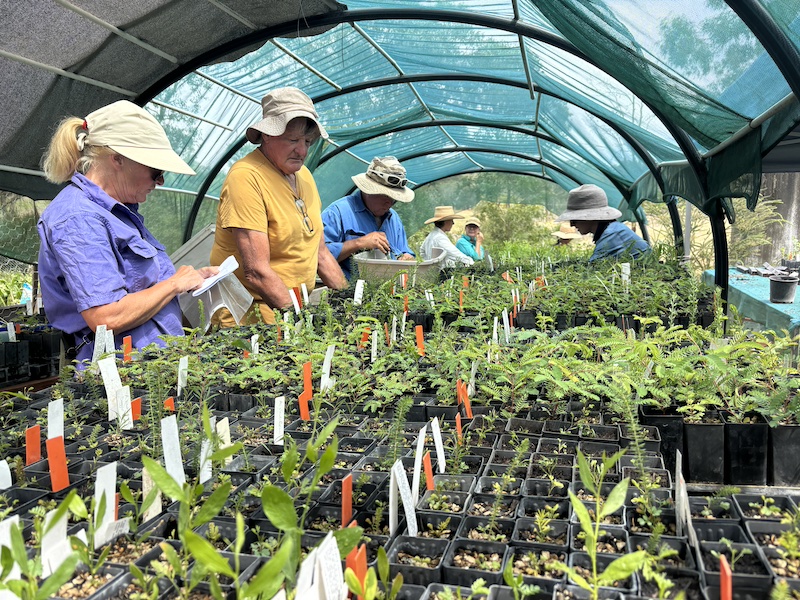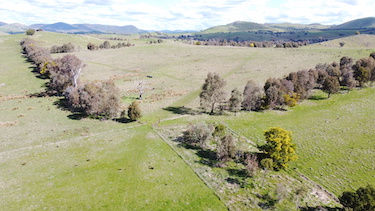Using locally-sourced seed has long been considered best practise when it comes to restoring native vegetation. But climate change is requiring us to question how well-adapted our local plant populations will be in the near future. Before roads, suburbs, crops and other barriers were established, plants were able to disperse across the landscape, creating new genetic combinations for natural selection to work on. In this way, vegetation has been able to adapt to past (slower) climate changes including ice ages and increasing aridity.
For over six years, a dedicated group of people have been giving serious thought to what temperature and rainfall changes mean for Landcare nurseries in the Yass area. These nurseries are run by volunteers. The plants are intended for long-term ecological restoration, so it is important for the material to be as ‘climate-ready’ as possible.

Climate modelling has predicted that our region is going to be hotter and dryer. For example, in 25 years, Canberra’s climate is likely to resemble that of Cootamundra if emissions are not curbed.
Starting with the list of local indigenous plants currently grown in the nurseries, the team identified those that have a natural distribution that extends into regions that approximate our future climate. These are most likely to have a tolerance of future climatic conditions. Of the 90 species have been analysed in this way, about two thirds seem likely to be able to tolerate warmer, drier conditions.
The analysis assists the nursery managers to choose species. The strategy is to obtain seed of natural populations from their entire geographic range, including the hot part of their range. This ‘admixture’ strategy provides a diverse genetic base for natural selection and adaptation in the future. There are too many other factors beyond temperature and drought tolerance to be able to predict the most favoured genetic combinations — nature will tell us eventually.
The time and effort that Landcare members have freely given to species selection, seed sourcing and growing these climate-ready plants, should be appreciated. This best takes the form of caring for the plants once they are in your hands. Choosing the planting site ahead of delivery is vital, so tubestock can go into the ground quickly once it leaves the nursery. This applies to all native plantings if the aim is permanent improvement of the local environment. The true value of climate-ready plantings will be when they regenerate and provide ongoing opportunities for adaptation.

Sites that are suitable would include:
Depleted native vegetation – Past clearing and grazing may have reduced population size and numbers of species, but these sites are ideal for supplementary planting.
Around existing remnant vegetation – Plantings are very effective if they serve to increase the area of native vegetation, and boost the size of existing native populations.
Pasture dominated by native grasses – An abundance of Kangaroo, Wallaby or other native grasses indicates that the ecosystem would support regenerating populations of trees and shrubs. Do not apply herbicides or deep-ripping in the last two situations – this will promote weeds and reduce the diversity of grasses and herbs. Plantings that are very dense will also reduce ground layer diversity.
Avoid:
Places with a history of repeated cultivation and fertilizer – although these are most likely suitable if they have been grazed for 10-20 years, without fertilizer addition.
Exotic perennial pastures - A strong presence of Phalaris, Fescue, Cocksfoot, clovers etc will inhibit establishment and future regeneration of native plants.
Fenceline plantings less than 30 m wide – Narrow plantings will not allow viable native vegetation to establish in an agricultural landscape.
Plants are available in autumn to financial members of Landcare. Visit yan.org.au to link to your local group, and for links to further information on planting methods and strategies. The ‘Projects’ tab on the home page has a wealth of detail about the ‘Climate Ready Revegetation Project’.
Join now, and get cracking!
Written by Sue Mcintyre
You may also like to read . . .
>> Exploring Local Climate Futures
>> Climate Ready Reveegetation Team: Preparing for a Changing Future
